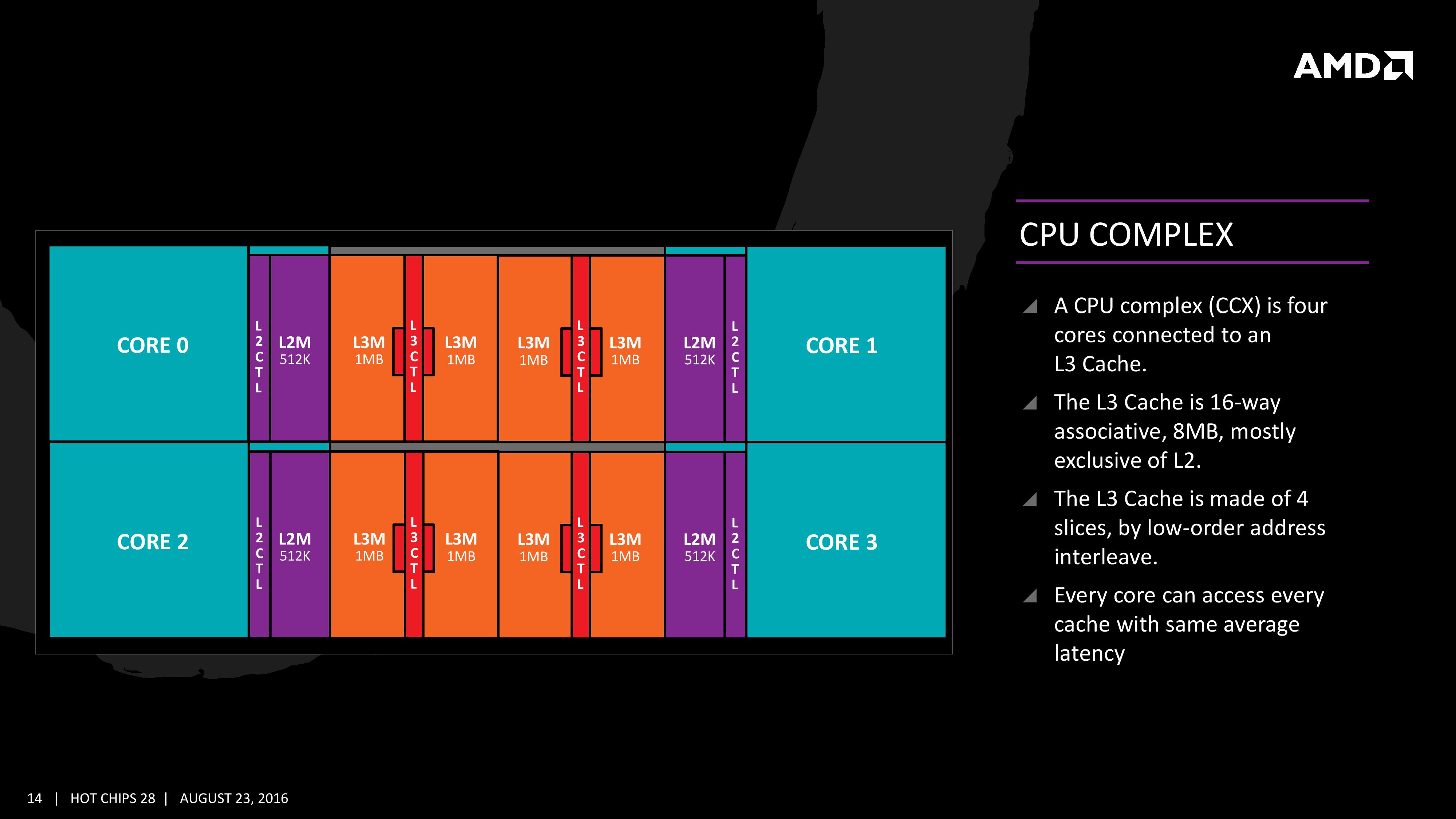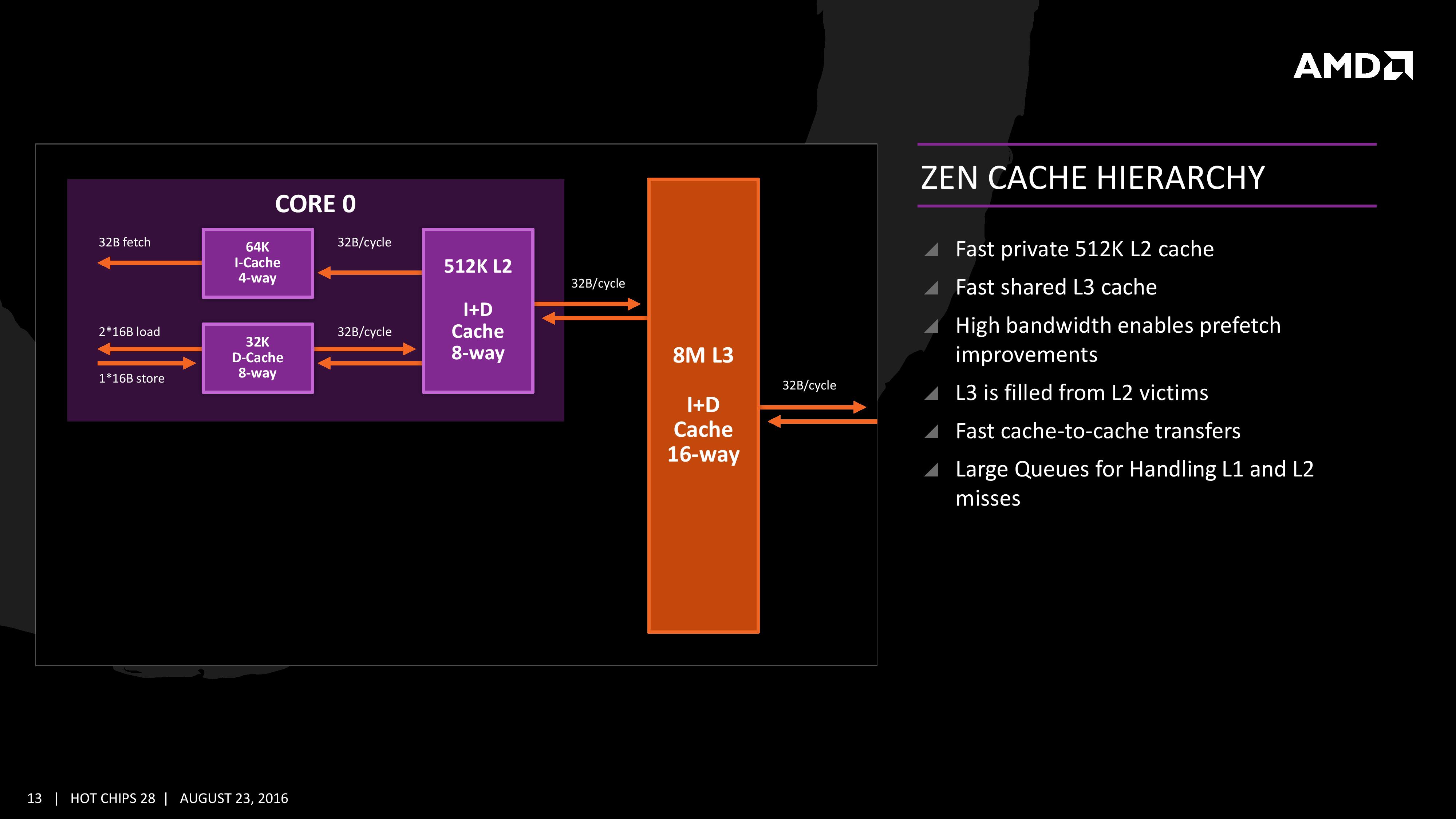The AMD Zen and Ryzen 7 Review: A Deep Dive on 1800X, 1700X and 1700
by Ian Cutress on March 2, 2017 9:00 AM ESTThe Core Complex, Caches, and Fabric
Many core designs often start with an initial low-core-count building block that is repeated across a coherent fabric to generate a large number of cores and the large die. In this case, AMD is using a CPU Complex (CCX) as that building block which consists of four cores and the associated caches.
Each core will have direct access to its private L2 cache, and the 8 MB of L3 cache is, despite being split into blocks per core, accessible by every core on the CCX with ‘an average latency’ also L3 hits nearer to the core will have a lower latency due to the low-order address interleave method of address generation.
The L3 cache is actually a victim cache, taking data from L1 and L2 evictions rather than collecting data from prefetch/demand instructions. Victim caches tend to be less effective than inclusive caches, however Zen counters this by having a sufficiency large L2 to compensate. The use of a victim cache means that it does not have to hold L2 data inside, effectively increasing its potential capacity with less data redundancy.
It is worth noting that a single CCX has 8 MB of cache, and as a result the 8-core Zen being displayed by AMD at the current events involves two CPU Complexes. This affords a total of 16 MB of L3 cache, albeit in two distinct parts. This means that the true LLC for the entire chip is actually DRAM, although AMD states that the two CCXes can communicate with each other through the custom fabric which connects both the complexes, the memory controller, the IO, the PCIe lanes etc.
The cache representation shows L1 and L2 being local to each the core, followed by 8MB of L3 split over several cores. AMD states that the L1 and L2 bandwidth is nearly double that of Excavator, with L3 now up to 5x for bandwidth, and that this bandwidth will help drive the improvements made on the prefetch side. AMD also states that there are large queues in play for L1/L2 cache misses.
One interesting story is going to be how AMD’s coherent fabric works. For those that follow mobile phone SoCs, we know fabrics and interconnects such as CCI-400 or the CCN family are optimized to take advantage of core clusters along with the rest of the chip. A number of people have speculated that the fabric used in AMD’s new design is based on HyperTransport, however AMD has confirmed that they are using a superset HyperTransport here for Zen, and that the Infinity fabric design is meant to be high bandwidth, low latency, and be in both Zen and Vega as well as future products. Almost similar to the CPU/GPU roadmaps, the Fabric has its own as well.
Ultimately the new fabric involves a series of control and data passing structures, with the data passing enabling third-party IP in custom designs, a high-performance common bus for large multi-unit (CPU/GPU) structures, and socket to socket communication. The control elements are an extension of power management, enabling parts of the fabric to duty cycle when not in use, security by way of memory management and detection, and test/initialization for activities such as data prefetch.














574 Comments
View All Comments
rudolphna - Thursday, March 2, 2017 - link
Demonizing gamers in your post does nothing to contribute to your credibility, and will only turn off more well reasoned people from listening, or caring, about your opinion.samer1970 - Friday, March 3, 2017 - link
Gamers dont buy 8 cores chips .. If you want good AMD gaming chip at very low price , wait for the 6 and 4 cores Ryzen and then judge ...I expect the 4 cores/8 threads Ryzen at 150$ to blow Intel to pieces ... SOON ..
Imagine a 4.5Ghz AMD Ryzen 4 cores for $150 then talk .
Sttm - Friday, March 3, 2017 - link
4 cores that are noticeably slower than Intel's 4 cores, which sell in a handsome i5 package for $200. I think they need a software miracle and they need it fast to win over the gaming crowd.Cooe - Sunday, February 28, 2021 - link
Bet you're feeling like a massive idiot now if you actually got that 4c/4t Kaby Lake i5 over a 6c/12t Ryzen 5 1600. It was about as fast at 1080p gaming in 2017 as the R5, but nowadays isn't even in the same UNIVERSE as the Ryzen chip. Let alone the performance difference for literally EVERYTHING else.Diji1 - Thursday, March 2, 2017 - link
Hurr durr you don't like what I like so you're a dumbo making me smarter than you! (yes, I know but they cannot see it themselves because their so smart in their own imagination).JoeyJoJo123 - Thursday, March 2, 2017 - link
What exactly are you trying to say here?Holliday75 - Thursday, March 2, 2017 - link
I think it was "Hurr durr".BikeDude - Friday, March 3, 2017 - link
sounded more like 'hold door' to me?star-affinity - Thursday, March 2, 2017 - link
I didn't know what is considered "wasting your life" is objective – please elaborate. What do you do with your life that makes it better than someone who likes to plays RPGs?Dug - Friday, March 3, 2017 - link
I'm so glad you are the one to judge what people are when they play games. Your insight and thought process is inspiring.I'm only to guess that what you do with a computer is going to change the world.